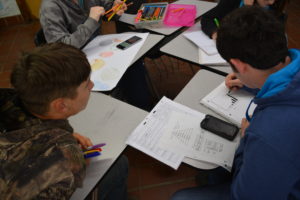<Activities…Labs…Techniques…Theories…X-content>
STEM
- Ask questions and define problems
- Develop and use models
- Plan and conduct investigations
- Analyze and interpret data
- Use mathematical and computational thinking
- Construct explanations and design solutions
- Engage in scientific argument from evidence
- Obtain, evaluate, and communicate information
The Crosscutting Concepts represent common threads or themes that span across science disciplines (biology, chemistry, physics, environmental science, Earth/space science) and have value to both scientists and engineers because they identify universal properties and processes found in all disciplines.
Seven crosscutting concepts:
- Patterns
- Cause and Effect: Mechanisms and explanations
- Scale, Proportion, and Quantity
- Systems and System Models
- Energy and Matter: Flows, cycles, and conservation
- Structure and Function
- Stability and Change
Analyze and interpret data
- Biology Topics 18 21 22 34
- Physical Science Topics 26 27 42
- Earth Science Topics 19 21 22 34 38
- Chemistry Topics 18 19 27 34 37 43
Ask questions and define problems
- Biology Topics 11 26 38 41 45
- Physical Science Topics 11 12 31 38
- Earth Science Topics 11 16 42
- Chemistry Topics 15 24 41 44 48
Construct explanations and design solutions
- Biology Topics 43 46 47
- Physical Science Topics 25 34 45
- Earth Science Topics 28 36 39
- Chemistry Topics 22 28 46
Develop and use models
- Biology Topics 13 14 15 17 32 35 42 48
- Physical Science Topics 14 32 35 39 46 47
- Earth Science Topics 13 15 24 31 32 33
- Chemistry Topics 12 16 25 32 35
Engage in scientific argument from evidence
- Biology Topics 16 19 24 25 31 44
- Physical Science Topics 13 15 16 44
- Earth Science Topics 17 23 41 43
- Chemistry Topics 13 23 33
Obtain, evaluate, and communicate information
- Biology Topics 33 39
- Physical Science Topics 21 24 41
- Earth Science Topics 14 27 37
- Chemistry Topics 11 14 38
Plan and conduct investigations
- Biology Topics 12 28 37
- Physical Science Topics 17 33
- Earth Science Topics 18 44 45 46
- Chemistry Topics 17 26 36 42 47
Use mathematical and computational thinking
- Biology Topics 23 27 36
- Physical Science Topics 18 19 22 23 43
- Earth Science Topics 25 26 35
- Chemistry Topics 21 31 39 45
Cause and Effect: Mechanisms and explanations
- Biology Topics 33 43
- Physical Science Topics 17 22 23 27 35 47
- Earth Science Topics 17 24 31 41
- Chemistry Topics 22 23 35 42
Energy and Matter: Flows, cycles, and conservation
- Biology Topics 23 44
- Physical Science Topics 11 12 24 26 31 34 39
- Earth Science Topics 19 25 27 33
- Chemistry Topics 11 27
Patterns
- Biology Topics 13 31 36
- Physical Science Topics 15 41 45
- Earth Science Topics 21 32
- Chemistry Topics 14 15 17 25 36
Scale, Proportion, and Quantity
- Biology Topics 34 39 46
- Physical Science Topics 42 43 46
- Earth Science Topics 11 14 35 36 42
- Chemistry Topics 18 19 26
Stability and Change
- Biology Topics 11 24 25 26 27 48
- Physical Science Topics 13 19 21 38 44
- Earth Science Topics 16 18 26 34 38 39
- Chemistry Topics 13 31 39 45 46 47
Structure and Function
- Biology Topics 14 15 16 18 19 37 38 42
- Physical Science Topics 14 16 18
- Earth Science Topics 37
- Chemistry Topics 12 21 33 34 41 43 44 48
Systems and System Models
- Biology Topics 12 17 21 22 28 32 35 41 45 47
- Physical Science Topics 25 32 33
- Earth Science Topics 13 15 22 23 28 43 44 45 46
- Chemistry Topics 16 24 28 32 37 38
About this Page
This web site provides free-to-use curriculum for high school teachers, students, and parent-guardians. Not all topics, concepts, and principles fit neatly within a single science discipline. For example, emphasis of 21st Century Skills (communication, creativity, collaboration, and critical thinking) apply to all of the natural sciences. We have divided our cross-cutting content into categories as grouped and described below.
More
This web site provides free-to-use science curriculum for high school teachers, students, and parent-guardians. Quickly scan available topics for biology, chemistry, earth science, physical science, and psychology. Discover more about John Honeycutt, creator of Honeycutt Science.
About us ……… Terms of use

